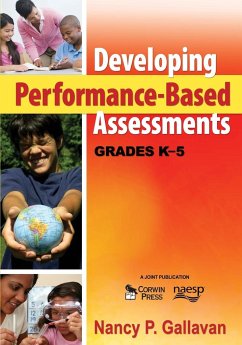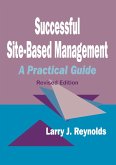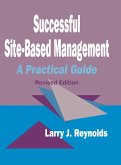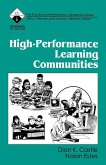Nancy P Gallavan
Developing Performance-Based Assessments, Grades K-5
Nancy P Gallavan
Developing Performance-Based Assessments, Grades K-5
- Broschiertes Buch
- Merkliste
- Auf die Merkliste
- Bewerten Bewerten
- Teilen
- Produkt teilen
- Produkterinnerung
- Produkterinnerung
Use PBAs to design learning experiences that increase student engagement and achievement! This book explains performance-based assessments (PBAs) in easy-to-understand terms and describes how to construct PBAs that measure learner performance effectively while allowing educators to align curriculum and instruction with students' needs. Using PBAs, teachers can engage students in the learning process, connect the learning to students' individual lives, and monitor learning outcomes. The author provides: - detailed and clear examples of performance-based assessments - tools for assessment and…mehr
Andere Kunden interessierten sich auch für
![Successful Site-Based Management Successful Site-Based Management]() Larry J. ReynoldsSuccessful Site-Based Management42,99 €
Larry J. ReynoldsSuccessful Site-Based Management42,99 €![Quick and Easy Ways to Connect with Students and Their Parents, Grades K-8 Quick and Easy Ways to Connect with Students and Their Parents, Grades K-8]() Diane MierzwikQuick and Easy Ways to Connect with Students and Their Parents, Grades K-836,99 €
Diane MierzwikQuick and Easy Ways to Connect with Students and Their Parents, Grades K-836,99 €![Developing Successful K-8 Schools Developing Successful K-8 Schools]() Jon WilesDeveloping Successful K-8 Schools77,99 €
Jon WilesDeveloping Successful K-8 Schools77,99 €![Successful Site-Based Management Successful Site-Based Management]() Larry J. ReynoldsSuccessful Site-Based Management79,99 €
Larry J. ReynoldsSuccessful Site-Based Management79,99 €![Developing Successful K-8 Schools Developing Successful K-8 Schools]() Jon WilesDeveloping Successful K-8 Schools33,99 €
Jon WilesDeveloping Successful K-8 Schools33,99 €![Developing Highly Qualified Teachers Developing Highly Qualified Teachers]() Allan A. GlatthornDeveloping Highly Qualified Teachers33,99 €
Allan A. GlatthornDeveloping Highly Qualified Teachers33,99 €![High-Performance Learning Communities High-Performance Learning Communities]() Dian K. CastleHigh-Performance Learning Communities26,99 €
Dian K. CastleHigh-Performance Learning Communities26,99 €-
-
-
Use PBAs to design learning experiences that increase student engagement and achievement! This book explains performance-based assessments (PBAs) in easy-to-understand terms and describes how to construct PBAs that measure learner performance effectively while allowing educators to align curriculum and instruction with students' needs. Using PBAs, teachers can engage students in the learning process, connect the learning to students' individual lives, and monitor learning outcomes. The author provides: - detailed and clear examples of performance-based assessments - tools for assessment and guidelines for creating and using rubrics - checklists, frequently asked questions, graphic organizers, and activities to reinforce the content in each chapter.
Hinweis: Dieser Artikel kann nur an eine deutsche Lieferadresse ausgeliefert werden.
Hinweis: Dieser Artikel kann nur an eine deutsche Lieferadresse ausgeliefert werden.
Produktdetails
- Produktdetails
- Verlag: Corwin
- Seitenzahl: 234
- Erscheinungstermin: 1. Dezember 2008
- Englisch
- Abmessung: 254mm x 178mm x 13mm
- Gewicht: 449g
- ISBN-13: 9781412966092
- ISBN-10: 1412966094
- Artikelnr.: 25053568
- Herstellerkennzeichnung
- Produktsicherheitsverantwortliche/r
- Europaallee 1
- 36244 Bad Hersfeld
- gpsr@libri.de
- Verlag: Corwin
- Seitenzahl: 234
- Erscheinungstermin: 1. Dezember 2008
- Englisch
- Abmessung: 254mm x 178mm x 13mm
- Gewicht: 449g
- ISBN-13: 9781412966092
- ISBN-10: 1412966094
- Artikelnr.: 25053568
- Herstellerkennzeichnung
- Produktsicherheitsverantwortliche/r
- Europaallee 1
- 36244 Bad Hersfeld
- gpsr@libri.de
Nancy P. Gallavan is professor of teacher education in the MAT program at the University of Central Arkansas. She worked as an elementary and middle school teacher in the St. Vrain Valley and Cherry Creek School Districts of Colorado for twenty years while earning her master's degree from the University of Colorado and her PhD from the University of Denver. Prior to her current position, she was an associate professor of teacher education specializing in social studies and multicultural education at the University of Nevada, Las Vegas. Gallavan has authored more than sixty publications, including books, chapters, and articles in professional education journals. Her books include Secrets to Success for Elementary School Teachers (2007) and Secrets to Success for Social Studies Teachers (2008) with Ellen Kottler and What Principals Need to Know About Teaching Social Studies (2003). She is active in the American Educational Research Association (AERA), the Association of Teacher Educators (ATE), the National Association for Multicultural Education (NAME), and the National Council for the Social Studies (NCSS).
Acknowledgments
About the Author
Introduction
1. Examining the Many Purposes of Assessment
Demystify Performance-Based Assessments
Understand the Six Components of Assessment
Picture the Continuous Flow of Assessment
Know the Reasons for Selecting Your Assessments...
Extend With Questions and Activities
2. Planning Assessments to Promote Understanding
Use Formal and Informal Assessments
Become a Data-Driven Teacher
Understand Assessment Principles and Practices
Watch for Common Errors in Assessing
Visualize the Overall Process...
Extend With Questions and Activities
3. Collecting Baseline Data for Preassessments
Set Three Goals to Guide Your Preassessments
Question Each of the Six Components of Assessment
Keep Anecdotal Records
Follow These Guidelines as You Preassess
Realize That Assessment Is a Continuous Process...
Extend With Questions and Activities
4. Aligning Appropriate Formative Assessments
Consider the Six Components of Assessment
Design Your Curriculum
Align Assessments With Curriculum and Instruction
Explore Cognition Via Patterns of Thought
Plan With Competence and Confidence...
Extend With Questions and Activities
5. Incorporating Learning, Assigning Instruction Followed by Feedback and
Correction
Assign Your Instruction and Activities
Employ Multiple Instructional Strategies
Consider These Assessment Recommendations
Include All Kinds of Questions With Your Formative Assessments
Optimize the Feedback
Involve Your Learners in the Process
Have Fun With Formative Assessments...
Extend With Questions and Activities
6. Administering Summative Assessments
Connect to the Goals and Components of Assessment
Create Your Summative Assessments
Prepare Learners for Summative Assessments
Set Your Sights on the Five As
Continue the Assessment Cycle...
Extend With Questions and Activities
7. Identifying What to Assess: Inviting the Five Types of Inquiry and
Information
Introduce the Five Types of Inquiry
Balance Three Conditions With Five Types of Inquiry
Delve Into Responses
Enhance Variety in Your Inquiries
Include All Types of Thinking, Acting, and Feeling...
Extend With Questions and Activities
8. Analyzing How to Assess: Applying the Five Forms of Appraisal and
Authentication
Analyze the Five Forms of Appraisal and Authentication
Implement Assessments Purposefully
Develop Appraisals to Showcase Learning...
Extend With Questions and Activities
9. Creating Assessment Templates and Rubrics
Construct the Assessment Template
Build Rubrics
Let Your Templates and Rubrics Do the Work for You...
Extend With Questions and Activities
10. Conducting Evaluations and Accountability
Evaluate Accomplishments
Account for Progress
Concentrate on Your Effectiveness
Develop a Performance-Based Assessment Mindset...
Extend With Questions and Activities
References and Readings
Index
About the Author
Introduction
1. Examining the Many Purposes of Assessment
Demystify Performance-Based Assessments
Understand the Six Components of Assessment
Picture the Continuous Flow of Assessment
Know the Reasons for Selecting Your Assessments...
Extend With Questions and Activities
2. Planning Assessments to Promote Understanding
Use Formal and Informal Assessments
Become a Data-Driven Teacher
Understand Assessment Principles and Practices
Watch for Common Errors in Assessing
Visualize the Overall Process...
Extend With Questions and Activities
3. Collecting Baseline Data for Preassessments
Set Three Goals to Guide Your Preassessments
Question Each of the Six Components of Assessment
Keep Anecdotal Records
Follow These Guidelines as You Preassess
Realize That Assessment Is a Continuous Process...
Extend With Questions and Activities
4. Aligning Appropriate Formative Assessments
Consider the Six Components of Assessment
Design Your Curriculum
Align Assessments With Curriculum and Instruction
Explore Cognition Via Patterns of Thought
Plan With Competence and Confidence...
Extend With Questions and Activities
5. Incorporating Learning, Assigning Instruction Followed by Feedback and
Correction
Assign Your Instruction and Activities
Employ Multiple Instructional Strategies
Consider These Assessment Recommendations
Include All Kinds of Questions With Your Formative Assessments
Optimize the Feedback
Involve Your Learners in the Process
Have Fun With Formative Assessments...
Extend With Questions and Activities
6. Administering Summative Assessments
Connect to the Goals and Components of Assessment
Create Your Summative Assessments
Prepare Learners for Summative Assessments
Set Your Sights on the Five As
Continue the Assessment Cycle...
Extend With Questions and Activities
7. Identifying What to Assess: Inviting the Five Types of Inquiry and
Information
Introduce the Five Types of Inquiry
Balance Three Conditions With Five Types of Inquiry
Delve Into Responses
Enhance Variety in Your Inquiries
Include All Types of Thinking, Acting, and Feeling...
Extend With Questions and Activities
8. Analyzing How to Assess: Applying the Five Forms of Appraisal and
Authentication
Analyze the Five Forms of Appraisal and Authentication
Implement Assessments Purposefully
Develop Appraisals to Showcase Learning...
Extend With Questions and Activities
9. Creating Assessment Templates and Rubrics
Construct the Assessment Template
Build Rubrics
Let Your Templates and Rubrics Do the Work for You...
Extend With Questions and Activities
10. Conducting Evaluations and Accountability
Evaluate Accomplishments
Account for Progress
Concentrate on Your Effectiveness
Develop a Performance-Based Assessment Mindset...
Extend With Questions and Activities
References and Readings
Index
Acknowledgments
About the Author
Introduction
1. Examining the Many Purposes of Assessment
Demystify Performance-Based Assessments
Understand the Six Components of Assessment
Picture the Continuous Flow of Assessment
Know the Reasons for Selecting Your Assessments...
Extend With Questions and Activities
2. Planning Assessments to Promote Understanding
Use Formal and Informal Assessments
Become a Data-Driven Teacher
Understand Assessment Principles and Practices
Watch for Common Errors in Assessing
Visualize the Overall Process...
Extend With Questions and Activities
3. Collecting Baseline Data for Preassessments
Set Three Goals to Guide Your Preassessments
Question Each of the Six Components of Assessment
Keep Anecdotal Records
Follow These Guidelines as You Preassess
Realize That Assessment Is a Continuous Process...
Extend With Questions and Activities
4. Aligning Appropriate Formative Assessments
Consider the Six Components of Assessment
Design Your Curriculum
Align Assessments With Curriculum and Instruction
Explore Cognition Via Patterns of Thought
Plan With Competence and Confidence...
Extend With Questions and Activities
5. Incorporating Learning, Assigning Instruction Followed by Feedback and
Correction
Assign Your Instruction and Activities
Employ Multiple Instructional Strategies
Consider These Assessment Recommendations
Include All Kinds of Questions With Your Formative Assessments
Optimize the Feedback
Involve Your Learners in the Process
Have Fun With Formative Assessments...
Extend With Questions and Activities
6. Administering Summative Assessments
Connect to the Goals and Components of Assessment
Create Your Summative Assessments
Prepare Learners for Summative Assessments
Set Your Sights on the Five As
Continue the Assessment Cycle...
Extend With Questions and Activities
7. Identifying What to Assess: Inviting the Five Types of Inquiry and
Information
Introduce the Five Types of Inquiry
Balance Three Conditions With Five Types of Inquiry
Delve Into Responses
Enhance Variety in Your Inquiries
Include All Types of Thinking, Acting, and Feeling...
Extend With Questions and Activities
8. Analyzing How to Assess: Applying the Five Forms of Appraisal and
Authentication
Analyze the Five Forms of Appraisal and Authentication
Implement Assessments Purposefully
Develop Appraisals to Showcase Learning...
Extend With Questions and Activities
9. Creating Assessment Templates and Rubrics
Construct the Assessment Template
Build Rubrics
Let Your Templates and Rubrics Do the Work for You...
Extend With Questions and Activities
10. Conducting Evaluations and Accountability
Evaluate Accomplishments
Account for Progress
Concentrate on Your Effectiveness
Develop a Performance-Based Assessment Mindset...
Extend With Questions and Activities
References and Readings
Index
About the Author
Introduction
1. Examining the Many Purposes of Assessment
Demystify Performance-Based Assessments
Understand the Six Components of Assessment
Picture the Continuous Flow of Assessment
Know the Reasons for Selecting Your Assessments...
Extend With Questions and Activities
2. Planning Assessments to Promote Understanding
Use Formal and Informal Assessments
Become a Data-Driven Teacher
Understand Assessment Principles and Practices
Watch for Common Errors in Assessing
Visualize the Overall Process...
Extend With Questions and Activities
3. Collecting Baseline Data for Preassessments
Set Three Goals to Guide Your Preassessments
Question Each of the Six Components of Assessment
Keep Anecdotal Records
Follow These Guidelines as You Preassess
Realize That Assessment Is a Continuous Process...
Extend With Questions and Activities
4. Aligning Appropriate Formative Assessments
Consider the Six Components of Assessment
Design Your Curriculum
Align Assessments With Curriculum and Instruction
Explore Cognition Via Patterns of Thought
Plan With Competence and Confidence...
Extend With Questions and Activities
5. Incorporating Learning, Assigning Instruction Followed by Feedback and
Correction
Assign Your Instruction and Activities
Employ Multiple Instructional Strategies
Consider These Assessment Recommendations
Include All Kinds of Questions With Your Formative Assessments
Optimize the Feedback
Involve Your Learners in the Process
Have Fun With Formative Assessments...
Extend With Questions and Activities
6. Administering Summative Assessments
Connect to the Goals and Components of Assessment
Create Your Summative Assessments
Prepare Learners for Summative Assessments
Set Your Sights on the Five As
Continue the Assessment Cycle...
Extend With Questions and Activities
7. Identifying What to Assess: Inviting the Five Types of Inquiry and
Information
Introduce the Five Types of Inquiry
Balance Three Conditions With Five Types of Inquiry
Delve Into Responses
Enhance Variety in Your Inquiries
Include All Types of Thinking, Acting, and Feeling...
Extend With Questions and Activities
8. Analyzing How to Assess: Applying the Five Forms of Appraisal and
Authentication
Analyze the Five Forms of Appraisal and Authentication
Implement Assessments Purposefully
Develop Appraisals to Showcase Learning...
Extend With Questions and Activities
9. Creating Assessment Templates and Rubrics
Construct the Assessment Template
Build Rubrics
Let Your Templates and Rubrics Do the Work for You...
Extend With Questions and Activities
10. Conducting Evaluations and Accountability
Evaluate Accomplishments
Account for Progress
Concentrate on Your Effectiveness
Develop a Performance-Based Assessment Mindset...
Extend With Questions and Activities
References and Readings
Index








